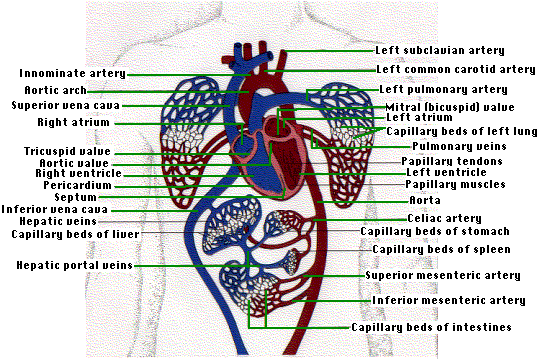15.3A: Anatomy of Human Circulatory System
- Page ID
- 5393
The circulatory system is an organ system that permits blood to circulate and transport nutrients (such as amino acids and electrolytes), oxygen, carbon dioxide, hormones, and blood cells to and from the cells in the body to provide nourishment and help in fighting diseases, stabilize temperature and pH, and maintain homeostasis.
Simplified diagram of the human Circulatory system in anterior view. (Public Domain; LadyofHats)
Main Features of the Human Circulatory System
- A liquid, blood, to transport nutrients, wastes, oxygen and carbon dioxide, and hormones.
- Two pumps (in a single heart): one to pump deoxygenated blood to the lungs and the other to pump oxygenated blood to all the other organs and tissues of the body
- A system of blood vessels to distribute blood throughout the body
- Specialized organs for exchange of materials between the blood and the external environment; for example organs like the lungs and intestine that add materials to the blood and organs like the lungs and kidneys that remove materials from the blood and deposit them back in the external environment
The Heart and Pulmonary System
The heart is located roughly in the center of the chest cavity. It is covered by a protective membrane, the pericardium.
- Deoxygenated blood from the body enters the right atrium.
- It flows through the tricuspid valve into the right ventricle. The term tricuspid refers to the three flaps of tissue that make up the valve.
- Contraction of the ventricle then closes the tricuspid valve and forces open the pulmonary valve.
- Blood flows into the pulmonary artery.
- This branches immediately, carrying blood to the right and left lungs.
- Here the blood gives up carbon dioxide and takes on a fresh supply of oxygen.
- The capillary beds of the lungs are drained by venules that are the tributaries of the pulmonary veins.
- Four pulmonary veins, two draining each lung, carry oxygenated blood to the left atrium of the heart.

The above figure shows the human heart, with a schematic view of the pathway of blood through the lungs and internal organs. Oxygenated blood is shown in red; deoxygenated blood in blue. Note that the blood draining the stomach, spleen, and intestines passes through the liver before it is returned to the heart. Here surplus or harmful materials picked up from those organs can be removed before the blood returns to the general circulation.
The Coronary System
From the left atrium,
- Blood flows through the mitral valve (also known as the bicuspid valve) into the left ventricle.
- Contraction of the ventricle closes the mitral valve and opens the aortic valve at the entrance to the aorta.
- The first branches from the aorta occur just beyond the aortic valve still within the heart.
- Two openings lead to the right and left coronary arteries, which supply blood to the heart itself. Although the coronary arteries arise within the heart, they pass directly out to the surface of the heart and extend down across it. They supply blood to the network of capillaries that penetrate every portion of the heart.
- The capillaries drain into two coronary veins that empty into the right atrium.
The coronary arteries arise at the point of maximum blood pressure in the circulatory system. Over the course of time, the arterial walls are apt to lose elasticity, which limits the amount of blood that can surge through them and hence limits the supply of oxygen to the heart. This condition is known as arteriosclerosis.
Alternatively, fatty deposits, called plaque, may accumulate on the interior surface of the coronary arteries; this condition is known as atherosclerosis. This is particularly common in people who have high levels of cholesterol in their blood. Plaque deposits reduce the bore of the coronary arteries and thus the amount of blood they can carry. Atherosclerosis (usually along with arteriosclerosis) may limit the blood supply to the heart that during times of stress the heart muscle is so deprived of oxygen that the pain of angina is created. It triggers the formation of a clot causing a coronary thrombosis. This stops the flow of blood through the vessel and the capillary network it supplies causing a heart attack. The portion of the heart muscle deprived of oxygen dies quickly of oxygen starvation. If the area is not too large, the undamaged part of the heart can, in time, compensate for the damage.
Coronary bypass surgery uses segments of leg veins to bypass the clogged portions of the coronary arteries.
The Systemic Circulation
The remainder of the system is known as the systemic circulation. The graphic shows the major arteries (in bright red) and veins (dark red) of the system. Blood from the aorta passes into a branching system of arteries that lead to all parts of the body. It then flows into a system of capillaries where its exchange functions take place.

Blood from the capillaries flows into venules which are drained by veins.
- Veins draining the upper portion of the body lead to the superior vena cava.
- Veins draining the lower part of the body lead to the inferior vena cava.
- Both empty into the right atrium.


